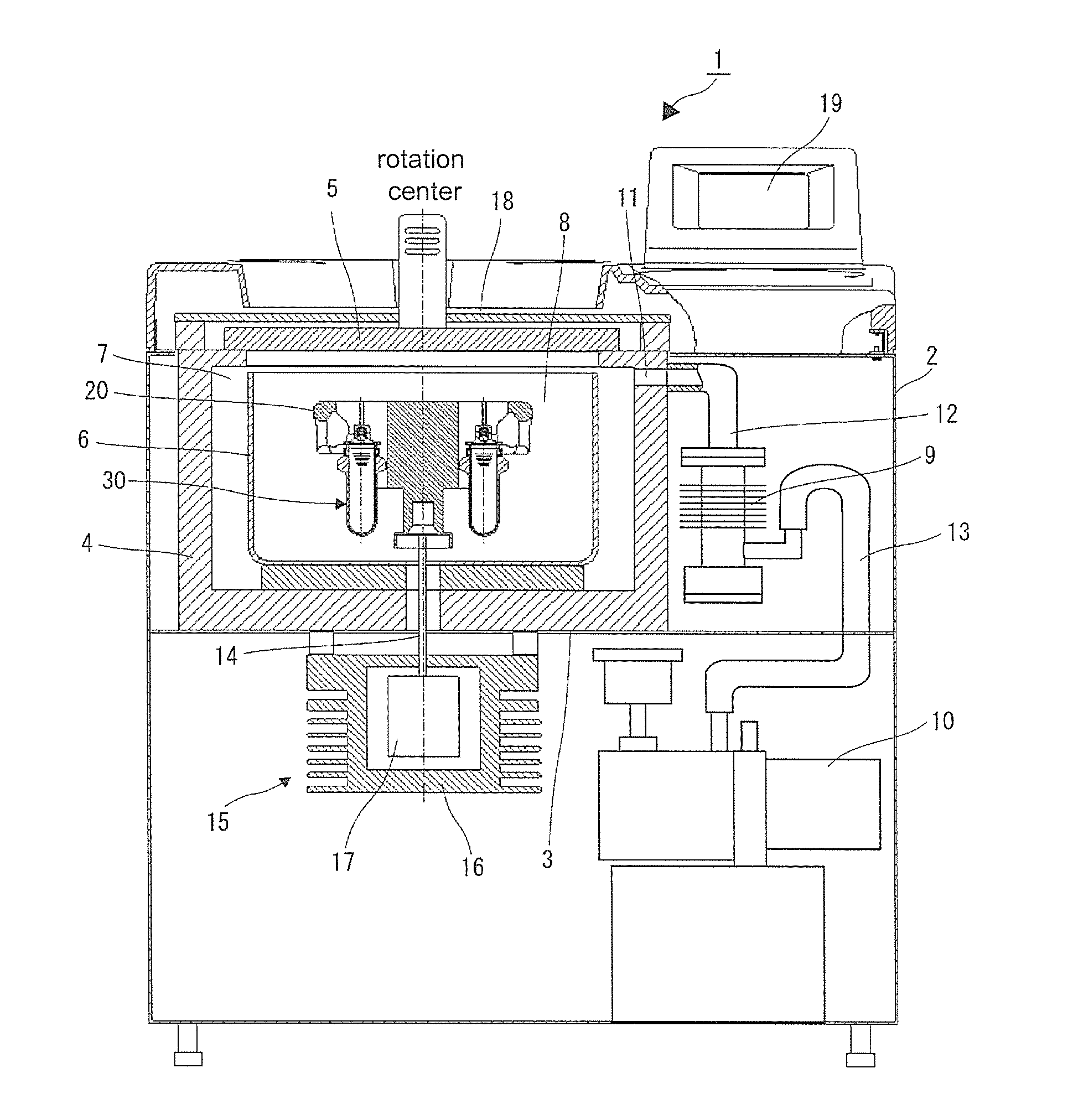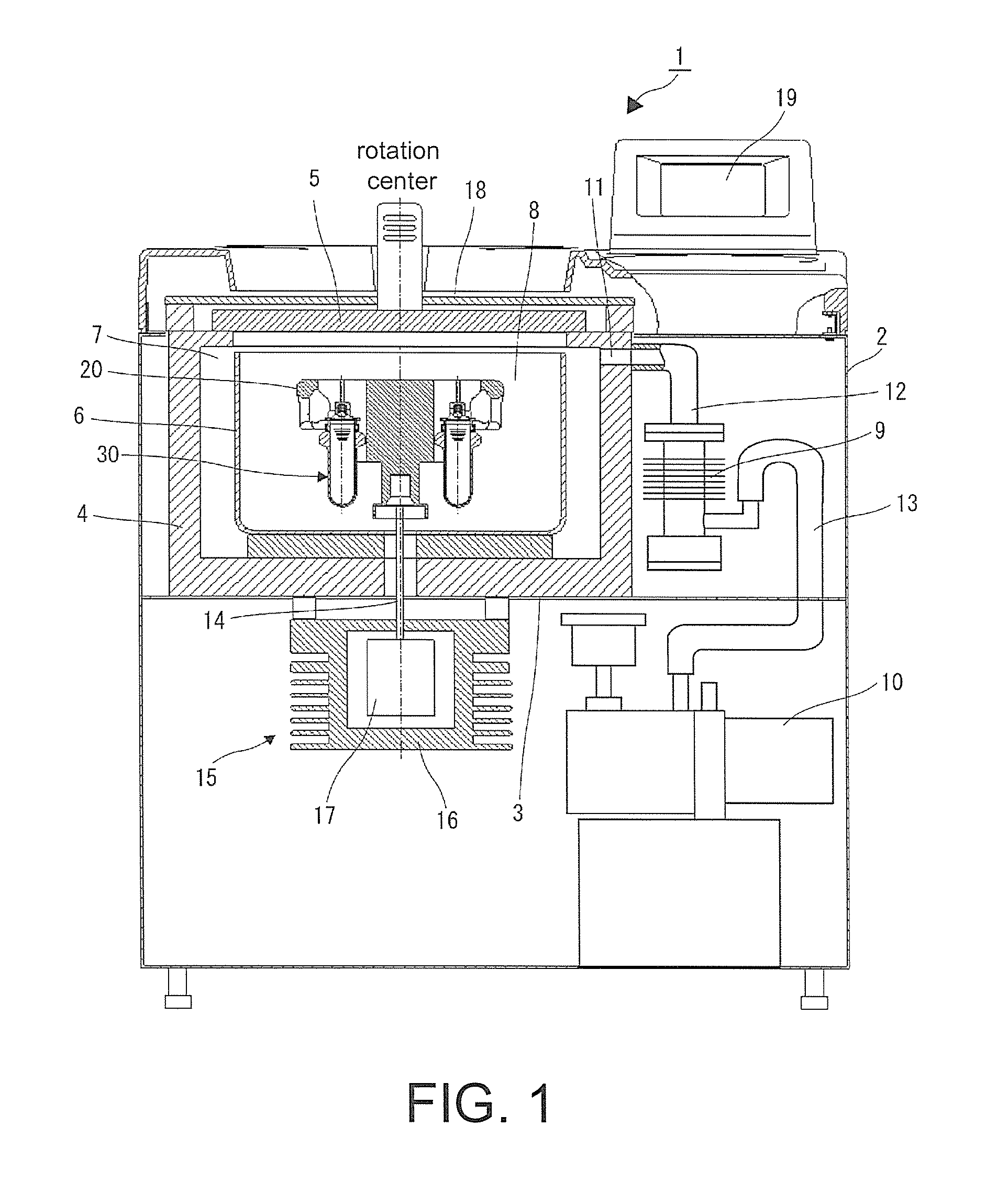Centrifuge and swing rotor for centrifuge
a centrifuge and swing rotor technology, applied in the direction of centrifuges, etc., can solve the problems of increasing centrifugal acceleration, large structure, and high cost of titanium materials, so as to prolong the life of the rotor, reduce the load weight, and reduce the bending moment.
- Summary
- Abstract
- Description
- Claims
- Application Information
AI Technical Summary
Benefits of technology
Problems solved by technology
Method used
Image
Examples
first embodiment
[0028]Referring to FIG. 1, a centrifuge 1 of the first embodiment is housed in a box-shaped case 2 that is made of sheet metal or plastic, and the interior of the case 2 is partitioned into an upper space and a lower space by a horizontal partition plate 3. A protective wall 4 is disposed in the upper space. The protective wall 4 and a door 5 define a decompression chamber 7 where a bowl 6 is housed. Then, by closing the door 5, the decompression chamber 7 is sealed by a door packing (not shown). The bowl 6 has a cylindrical shape that is open on the upper side. A rotor 20, on which a sample container 30 is disposed in a swingable manner, is housed in an interior space (rotor chamber 8) of the bowl 6.
[0029]An oil diffusion vacuum pump 9 and an oil rotation vacuum pump 10 are connected in series to serve as a vacuum pump for discharging the atmosphere in the decompression chamber 7 to create a vacuum (decompression). That is, a vacuum drawing opening 11 formed on the protective wall ...
second embodiment
[0056]In the second embodiment, referring to FIGS. 13(a)˜13(c), two rotating shafts 40′ are connected via a hollow part 32′ of a lid part 31. FIG. 13(a) is a perspective view showing the configuration of the rotating shafts 40′, FIG. 13(b) is a partial cross-sectional perspective view showing the configuration of the lid part 31′ including the rotating shafts 40′, and FIG. 13(c) is a longitudinal cross-sectional view showing the configuration of the lid part 31′ including the rotating shafts 40′.
[0057]As shown in FIG. 13(a), a connection part 43′ of the rotating shaft 40′ does not have the rotating shaft sliding surface 45 that the rotating shaft 40 has in the first embodiment, but has the pin sliding hole 45 and the contact surface 46. As shown in FIG. 13(b), two press-fit holes 36 (one of the press-fit holes 36 is not shown) are formed side by side in the horizontal direction on the peripheral surface of the hollow part 32′ of the lid part 31′. As shown in FIG. 13(b) and FIG. 13(c...
third embodiment
[0059]In the third embodiment, referring to FIGS. 14(a)˜14(b), two rotating shafts 40″ are connected via an intermediate member 47. FIG. 14(a) is a perspective view showing the configuration of the rotating shafts 40″ and FIG. 14(b) is a partial cross-sectional perspective view showing the configuration of a lid part 31″ including the rotating shafts 40″.
[0060]As shown in FIG. 14(a), the connection parts 43″ of the two rotating shafts 40″ are respectively connected to the intermediate member 47 by a pin 48. The pins 48 respectively connecting the two rotating shafts 40″ to the intermediate member 47 are set in parallel. Then, as shown in FIG. 14(b), the two rotating shafts 40″ connected via the intermediate member 47 are disposed such that the mutual connection parts 43″ and the intermediate member 47 are located in the hollow part 32″ of the lid part 31″, and like the first embodiment, the spacer 70 and the disc springs 71 are interposed between the contact surfaces 46 of the conne...
PUM
 Login to View More
Login to View More Abstract
Description
Claims
Application Information
 Login to View More
Login to View More - R&D
- Intellectual Property
- Life Sciences
- Materials
- Tech Scout
- Unparalleled Data Quality
- Higher Quality Content
- 60% Fewer Hallucinations
Browse by: Latest US Patents, China's latest patents, Technical Efficacy Thesaurus, Application Domain, Technology Topic, Popular Technical Reports.
© 2025 PatSnap. All rights reserved.Legal|Privacy policy|Modern Slavery Act Transparency Statement|Sitemap|About US| Contact US: help@patsnap.com



